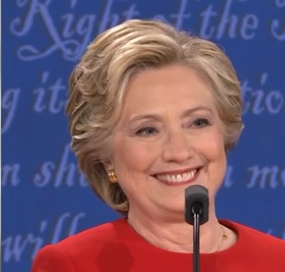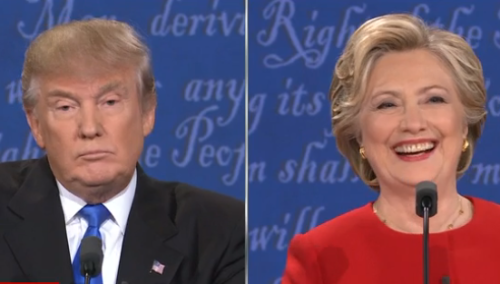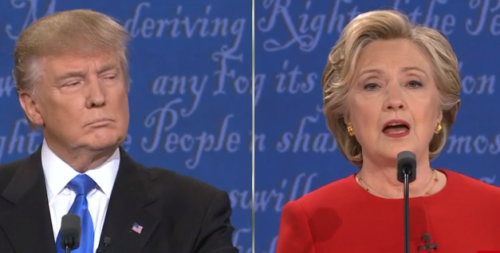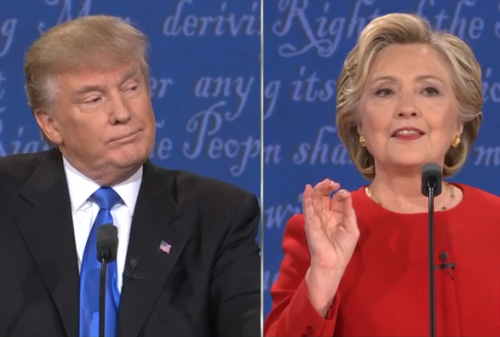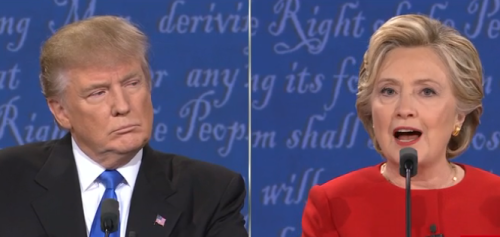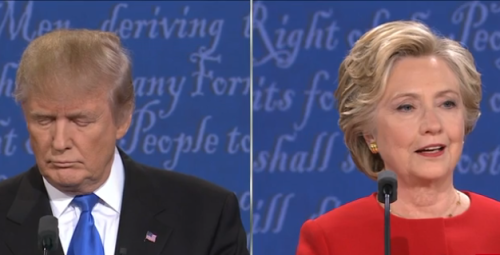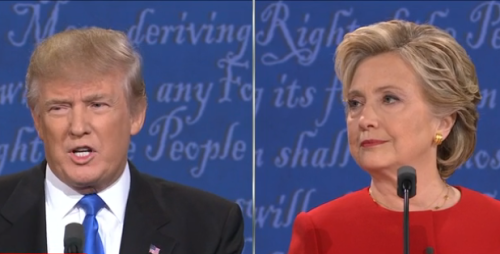By Dr. Ken Broda Bahm:
This is a political season for double standards, glass ceilings, and dancing backwards in high heels. Hillary Clinton, as the first female to be nominated for President by a major party, finds herself locked in a close race with one of the least conventional candidates in modern times, Donald Trump. That combination has created some interesting challenges, many of which are unique to the contest itself, but some of the challenges are new manifestations of a very old problem: gender, and more specifically the expectations attached to gender in public communication. I don’t want to fixate on gender just because one candidate is female, and as the debates move on, I will definitely get to the substance. But in watching the first general election debate between the candidates, what jumped out at me is the differences in nonverbal communication.
Maybe a focus on nonverbal communication is a natural result of it being the first debate: the first time we get to see the two candidates standing next to each other on the same stage at the same time. In fact, it was during the first debate of the last election cycle that I wrote the earlier “Look Like You’re Winning” post. At that time, it was Mitt Romney who looked confident and presidential while President Obama looked distracted and stressed. On Monday, however, it was Secretary Clinton who was seemed to have the best nonverbal presentation. While Donald Trump had previously criticized Clinton for not having a “presidential look,” it was she who looked poised and pleasant while he consistently looked aggravated and annoyed. If the facial expressions had been reversed, I believe it would have been seen as an unmitigated disaster for Clinton. The reason for that, of course, is pretty unfair, but it comes down to different standards and expectations for women. A stern and stressed male face isn’t ideal, but it isn’t considered out of character either. A stern and stressed female face, on the other hand, conflicts with some of the most fundamental traits we associate with women as communicators. In this post, I will take a look at the faces we saw on Monday’s debate and call out a few principles that matter most for women, but benefit all speakers.
I offer the points that follow, not so much as a critique of Trump — oddly, in this campaign, critiques of Trump haven’t seemed to have mattered, or at least they haven’t mattered nearly as much as they would have for another candidate. Instead, I offer these points mostly as praise for how well Clinton did in rising to adapt to the often unfair standards that are placed on women as communicators. Female litigators and female witnesses can take a few pointers, but really, it is good advice for all speakers.
Here is my list of the three main things Clinton did on Monday to lean forward and look like she’s winning:
One, Keep It Positive
It’s been a frequent critique of Hillary’s communication, and a point that isn’t generally made for male speakers: She should smile more. Whether that advice is fair or unfair, it is good advice. Women who smile are viewed as more credible, and studies show it is more necessary to female than to male credibility (Nagle, Brodsky & Weeter, 2014). And if you watch Clinton’s face throughout the debate, that is exactly what she did.
In fact, the more Trump attacked, the more Clinton smiled, at one point even breaking into a laugh as well as a now-famous shimmy. It seemed that the advice she was acting on, and it is good advice, is “No matter what he says, don’t take offense. Instead, respond with a bemused attitude. Humor him – don’t get mad.” And, to my eyes at least, the smile actually seemed genuine – a Duchenne smile that involves the full face rather than just the mouth – as if she really wanted to be there and really was having a good time. “Yes, I’ve got this” is what her face conveyed.
Two, Keep It Open
In trial, of course, a broad grin won’t always work and won’t always match the serious content. That match is important. But even when it isn’t appropriate to smile, it is still important to keep your facial expression open. By “open,” I mean that the brows, eyes, nose, and mouth are all maintaining a healthy and natural distance from one another, and nothing is pinched or scrunched together.
What the open face communicates is relaxed confidence and credibility. It is comfortable to look at a face with an open expression. In contrast, the face that is pinched can look like it is scowling and it can be uncomfortable to look at.
Another way of opening up one’s nonverbal communication is to make occasional use of gestures.
Three, Keep Your Focus
Keeping your focus means putting your attention where it belongs: on your target audience.
That means eye contact:
It means looking up and not down:
And it means having a confident “resting expression” that you use when you aren’t speaking, but when the eyes are still on you.
Of course, attorney presenters and witnesses will not – and should not – face the same microscopic level of scrutiny that political candidates will face: It is still okay to sniff from time to time. But witnesses and presenters can also increase their conveyed confidence, can look more like they’re winning, by practicing the same tactics: Keep a positive expression, keep your face open and not stressed, and keep your focus on your audience.
______
Other Posts on Delivery:
- Improve Delivery By Perfecting Your ‘TED Moves’
- Speak Extemporaneously: Seven Tips for Losing the Notes Without Going Off-the-Cuff
- Consider How You Come Across With the Volume Off
______
Image credit: All images taken from debate video hosted by C-Span.
